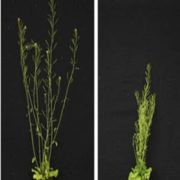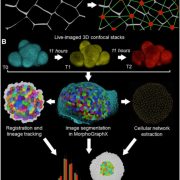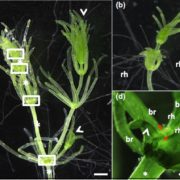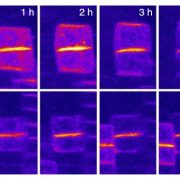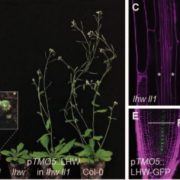Knock-down of rice microRNA166 confers drought resistance through changes in leaf morphology (Plant Physiol.)
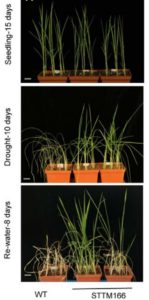 Under drought conditions, moderate leaf rolling improves yield in rice by reducing water loss and allowing efficient photosynthesis (leaf upright position). In STTM166 transgenic rice plants, miRNA166 is knocked down (STTM means “short tandem target mimic”) and the plants constitutively exhibit the rolled-leaf trait. Compared to wild-type plants, STTM166 plants exhibit an improved ability to grow new leaves after a period of water deficit, an increase in spikelet fertility under drought conditions and a decrease in leaf transpiration—all of which contribute to drought tolerance. The changes observed are ABA-independent and are due to modifications in leaf morphology. In addition, STTM166 plants have narrower xylem vessels, resulting in decreased shoot hydraulic conductivity compared to wild-type plants. The target of miRNA166 responsible for rolled-leaf trait is OsHB4, a homeodomain leucine zipper III transcription factor involved in adaxial polarity of the leaf. Rice plants overexpressing OsBH4 have improved drought tolerance. Through transcriptomic analysis, polysaccharide synthase genes are shown to be the downstream targets of the miR166-OsBH4 regulatory module. This study gives evidence to the importance of regulating leaf morphology to increase drought tolerance in rice. (Summary by Stephanie Saade) Plant Physiol. 10.1104/pp.17.01432
Under drought conditions, moderate leaf rolling improves yield in rice by reducing water loss and allowing efficient photosynthesis (leaf upright position). In STTM166 transgenic rice plants, miRNA166 is knocked down (STTM means “short tandem target mimic”) and the plants constitutively exhibit the rolled-leaf trait. Compared to wild-type plants, STTM166 plants exhibit an improved ability to grow new leaves after a period of water deficit, an increase in spikelet fertility under drought conditions and a decrease in leaf transpiration—all of which contribute to drought tolerance. The changes observed are ABA-independent and are due to modifications in leaf morphology. In addition, STTM166 plants have narrower xylem vessels, resulting in decreased shoot hydraulic conductivity compared to wild-type plants. The target of miRNA166 responsible for rolled-leaf trait is OsHB4, a homeodomain leucine zipper III transcription factor involved in adaxial polarity of the leaf. Rice plants overexpressing OsBH4 have improved drought tolerance. Through transcriptomic analysis, polysaccharide synthase genes are shown to be the downstream targets of the miR166-OsBH4 regulatory module. This study gives evidence to the importance of regulating leaf morphology to increase drought tolerance in rice. (Summary by Stephanie Saade) Plant Physiol. 10.1104/pp.17.01432


